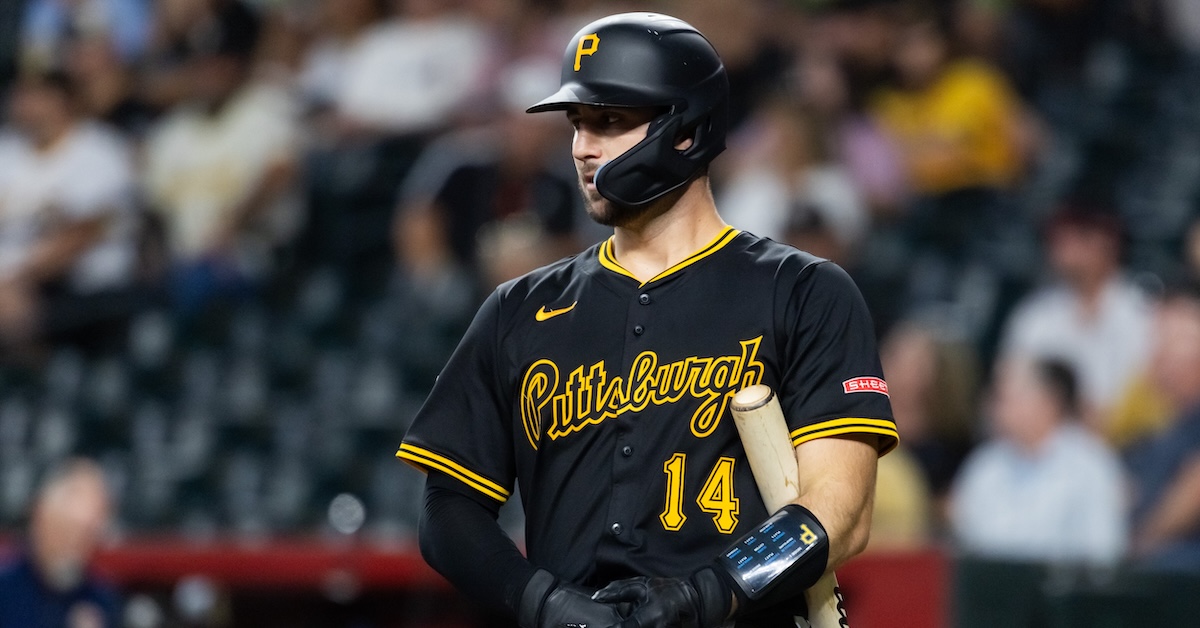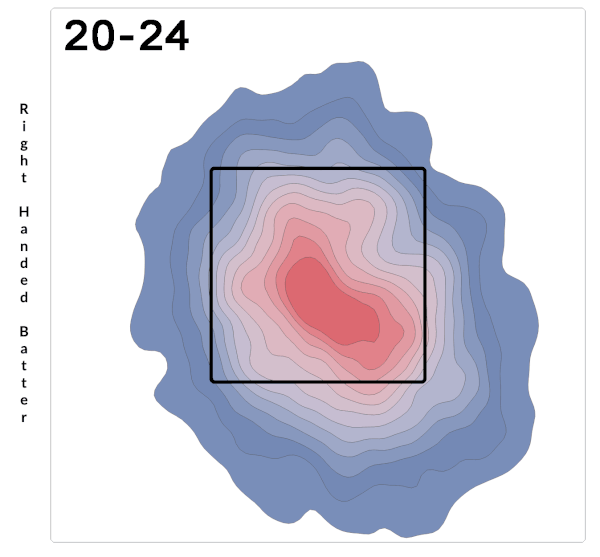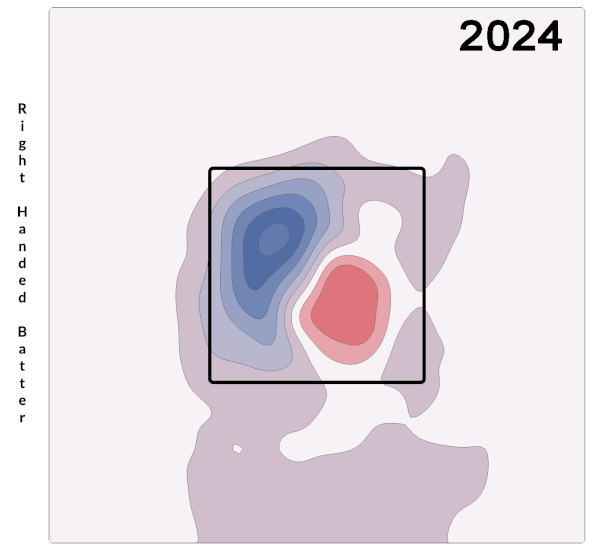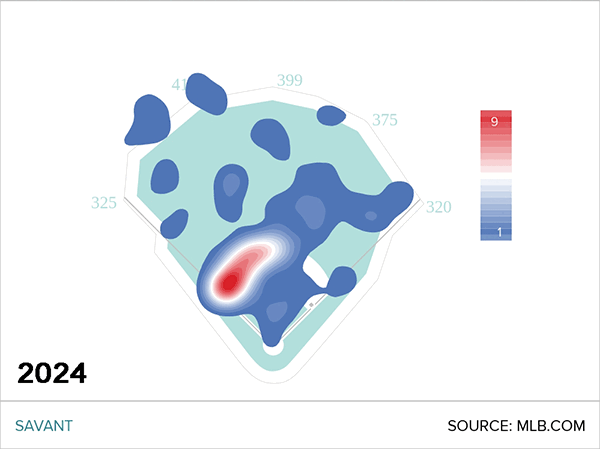Joey Bart, Plate Discipline God?

This is the time of year when people start telling me that my job must be so hard now that there’s no baseball to write about. It happens every offseason. I always protest. While it’s true that without major league games to watch, one particularly fun and fruitful source of article ideas has dried up, I actually love writing in November. The truth about who was dealing with an injury all year starts trickling out. The free agent market is shaping up. General managers are hinting at their plans. Scott Boras is unveiling a fresh batch of the worst puns imaginable. I get to dig into my notes app, where I’ve been stashing weird ideas for a rainy day. More importantly, it’s a great time to reflect on the season that was. Everything is still somewhat fresh in your mind, but you’re working with a full season’s worth of numbers. You don’t have to worry that a player’s going to dive into the world’s worst slump the moment after you write about their hot streak. You can write about players who perhaps aren’t changing the course of the season, but are interesting in their own way. It’s a great time to check the leaderboards for a surprise.
Today’s surprise appeared on the SEAGER leaderboard. That’s Robert Orr’s metric for SElective AGression, and players find their way to the top by swinging at hittable pitches and laying off bad ones. Corey Seager, forever on brand, finished the season in second place (and first in an unpublished updated version). Aaron Judge and Ronald Acuña Jr. finished first and fourth, respectively, which makes plenty of sense since they finished first and fourth in walk rate and also mashed the ball. It was third place that held the name that surprised me: Joey Bart. The 6-foot-3, 235-pound Bart has seen his numbers turn around a bit in the past two seasons. Because he’s a catcher who splits time, his numbers represent a smaller sample with more room for fluctuation, but it was still eye-opening to see him in that kind of company.
Once a Johnny Bench Award winner at Georgia Tech, the second overall pick in the 2018 draft, and the heir apparent to Buster Posey, Bart debuted in San Francisco during the shortened 2020 season and struggled with injuries and underperformance from the get-go. Over 162 games from 2020 to 2023, he batted .219 with just 11 home runs. To that point in his career, his wRC+ in the minors was 123, compared to 77 in the majors. In April 2024, after Bart had exhausted his minor league options and Patrick Bailey had impressed in his own 2023 debut, the Giants traded Bart to the Pirates. Our preseason projections saw him putting up below-average numbers both at the plate and behind it. Instead, he had a career year. Splitting time with Yasmani Grandal and 2021 first overall pick Henry Davis, Bart ran a 121 wRC+, the fourth-highest mark among catchers with at least 200 plate appearances. He bested his career total with 13 home runs.
Because Bart only got into 80 games, and because his defense graded out below average, his 1.3 WAR ranked just 29th among catchers and 24th on a per-plate appearance basis. Still, after the way his career started out, it was a genuine surprise to see him producing like a top-25 catcher and hitting like a star. He pledged to work on his defense during the offseason, and two of the three main defensive metrics graded him as improved in 2025. As you might expect, Bart’s offense came back down to Earth a bit this year, though his 101 wRC+ was still far better than anything he’d done before the 2024 season. He posted a .330 xwOBA in 2024 and .326 xwOBA in 2025. You could argue that the step back he took in 2025 was just a result of luck. However, his BABIP actually rose 35 points in 2025, DRC+ saw him fall from 106 to 93, and he only hit four home runs, dropping his 122 points off his slugging percentage. Then there’s the extreme jump in his SEAGER score, which brought him to my attention in the first place. Something else must have changed in 2025.
So what got into Bart over the last two seasons? And why didn’t he improve even more in 2025 if he suddenly had one of the best approaches in the game? Let’s start with plate discipline. In February, Alex Stumpf of MLB.com revealed that Bart had started working with a hitting coach before the 2024 season. He made some mechanical changes and worked on his approach. Earlier in his career, Bart said, he “just went up there and swung.” Now that’s a quote. “Bart just stopped swinging entirely,” wrote Patrick Dubuque of Baseball Prospectus at the end of the 2024 season, “showing Judge-level patience—except without the Judge-level intimidation.”
| Year | Chase% | Z-Swing% | Z-Contact% | F-Strike% | BB% | K% |
|---|---|---|---|---|---|---|
| 2020-23 | 32.2 | 63.0 | 76.5 | 67.2 | 6.4 | 35.4 |
| 2024 | 26.0 | 58.8 | 86.1 | 64.5 | 7.8 | 25.9 |
| 2025 | 22.8 | 58.5 | 85.2 | 54.5 | 12.0 | 28 |
The headline here isn’t just that Bart has gotten more patient. This is an entirely new approach, so different that you have to think he must be seeing the ball much better. He’s slashed his chase rate by nearly 10 points while dropping his swing rate on pitches in the zone much less – and not at all in 2025. That’s how he ended up at the top of the SEAGER leaderboard; he’s still way too passive on pitches in the zone, but he’s cut his chase rate so much that, at least according to this particular metric, it’s all worth it.
At the same time, Bart has added nearly nine points to his contact rate on pitches in the zone. To be clear, his contact rate is still well below average; he’s a big, strong guy with plus bat speed and that’s never going to be his game. But this looks like an entirely different player. His first-strike rate is down more than 12 percentage points. Twelve! Just from 2024 to 2025, he went from the 50th percentile in SEAGER to the 100th. He also saw far fewer pitches in the zone in the first place. No wonder his walk rate has nearly doubled in the past two seasons. It’s the kind of turnaround you expect to see (but rarely actually do) when a player gets laser eye surgery over the winter.
Put all this together – chasing less, getting ahead in the count more often, and making more contact in the zone – and you’d expect Bart to be hitting for more power, because the pitches he’s hitting are much juicier. To wit, in 2025, 53% of his balls in play came on pitches over the heart of the plate, compared to 48% in his previous seasons. Wouldn’t you know it, his hard-hit rate jumped by the same amount, going from just under 38% in 2024 to just over 43% in 2025. That brings us to an obvious question: If Bart is walking so much more, and he’s hitting the ball hard more often, why have his power numbers collapsed?
For starters, none of this happened in a vacuum. Pitchers started attacking Bart much differently this year. Specifically, they threw him more breaking stuff and didn’t pound him quite so far inside with fastballs:

For a big, strong guy like Bart, you’d think that would be a good thing. He also started setting up nearly two inches farther off the plate in 2025. All of sudden, he’s great at laying off offspeed pitches and breaking stuff off the plate. When he sees pitches on the outer half of the plate, he can get his arms extended and do damage out there, right? Not exactly. Here’s his run value on a per-pitch basis. Honestly, I’ve never seen anything like it:

From one year to the next, Bart went from being great on outside pitches and terrible on inside pitches to the complete opposite. That helps explain why pitchers started attacking him outside a bit more, as does a spray heat map to show where he actually hit the ball:

His pull rate dropped dramatically. He started going with the pitch, hitting it the other way and especially to the big part of the field. So even though his hard-hit rate went up dramatically, his pull rate on hard-hit balls dropped all the way from 49% to 35%. Unsurprisingly, his average exit velocity on those hard-hit balls dropped too. It’s a lot harder to hit home runs to center field. In 2024, Bart pulled 10 of his 13 homers, but in 2025, he pulled just one of four. Another thing happens when you meet the ball further away from your body: You also tend to meet the ball deeper in the zone, when your bat path isn’t as steep. That means groundballs, and Bart’s groundball rate has also jumped dramatically in the past two years. It’s actually risen in each of the past four years, but in 2025, it was all the way up at 52%. That’s one way to make sure that you don’t hit for power regardless of your hard-hit rate.
In some ways, this is a familiar story: A player’s approach gets too passive, and it leads to swings that are too passive too. They’re no longer going out and attacking the ball, and their contact quality and power numbers suffer. That’s my best guess here. Bart is going with the ball and trying to make more contact rather than leveraging his plus bat speed – his best tool – in order to hit it hard. But even if Bart’s numbers going forward look more like they did in 2025 than they did in 2024, this is still a real win. Bart has now put up two seasons in a row as at least a roughly average hitter, and he’s improved his defense too. The early projections see him as a roughly average catcher going forward, and that’s a big accomplishment after the way his career started out.
That’s a whole lot of analysis, and I still have more questions than answers. I’ve only given you a guess as to why Bart suddenly got so much worse on pitches out over the plate. I’m really curious about why he decided to set up further away from the plate, but it’s a difference of fewer than two inches. Maybe it wasn’t even intentional. And what exactly did that hitting coach tell him to change about his approach that caused such a dramatic shift? He’s laying off changeups, making more contact, and focusing on the strike zone, all because he’s no longer just going up there and swinging? I would love to know whether all of that will continue in 2026.
The biggest question for next season is how much Bart will get to play at all. The Pirates have four catchers who saw time in the majors last year, and Bart’s contract is out of options. They received Rafael Flores for David Bednar at the deadline. His defense is rough, but Flores has raked in the low minors and held his own in Triple-A, launching more than 20 home runs in each of the past two seasons. The Pirates were high enough on him to call him up for the last couple weeks of the season. And although he hasn’t hit at the big-league level for three years now, Davis has great defensive numbers and his peripherals ticked up in 2025. Lastly, they have Endy Rodriguez, whom we ranked second in the organization in 2023. Rodriguez started the 2025 season with the club, got sent down once, and then saw his season end early after ulnar nerve transposition surgery. It’s hard to know where the Pirates value Bart in that group. At this point though, amazingly, Bart has arguably the best track record of the bunch.
Davy Andrews is a Brooklyn-based musician and a writer at FanGraphs. He can be found on Bluesky @davyandrewsdavy.bsky.social.
Great article!